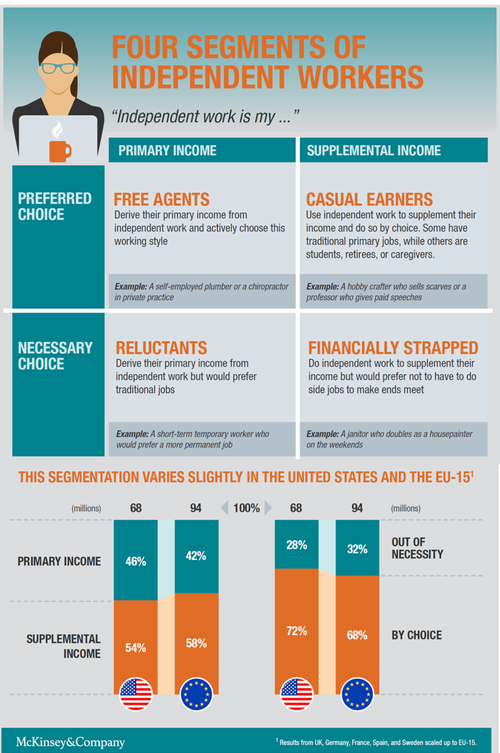Independent Work: Choice, Necessity, and the Gig Economy from the McKinsey Global Institute, is fascinating reading. If you’re in HR, talent acquisition or are a leader of people, you’ve probably been paying attention to the coverage of the “Gig Economy” or the “Contingent Workforce.” Mary Meeker wrote about it in the Internet Trends report, and I wrote about it here.
But the McKinsey white paper really delves into the phenomenon of independent work and it’s hard to look away. The report is 148 pages of fun and the executive summary is a mere 24 pages. They both pack a punch with data and graphs galore. Let’s just focus on the executive summary. If you like that, you can dig even deeper into the full report.
The premise of looking at the why of independent working arrangements is quite compelling. We all know that there are people driving for Uber or Lyft because they can’t connect back to the world of full-time employment following the Great Recession. McKinsey calls them “Reluctants.”
We also know there are lots of people driving for those organizations because they want to pick up some extra cash; they are the “Casual Earners.” The “Financially Strapped” are those who would never choose this arrangement but for their financial situation.
But we’re also probably aware that there are more and more people in the economy who are choosing to be “Free Agents,” who are intentionally leaving traditional employment models behind and reveling in their freedom.
There are a number of insights here that are worth noting:
- Independent work has three defining features: autonomy; payment by task, assignment, or sales; and a short term financial relationship.
- 20-30% of working adults in the U.S. and the EU-15 are independent workers of one kind of another. That’s up to 162 million workers! (54-68 million of them in the U.S.)
- Free agents (independent by choice as a primary source of revenue) report greater satisfaction with their work lives than those in traditional jobs.
- Currently only 15% of independent workers use digital platforms like Uber, Airbnb and Etsy – although their use is growing rapidly.
- 1 in 6 workers in traditional jobs would like to become primary independent workers. (That’s your 1 in 6.)
- Independent workers who sell goods (Etsy) or lease assets (Airbnb) are more likely to use digital platforms than those who provide labor services (TaskRabbit).

The executive summary ends with a discussion of the future: The impact of a continued shift toward independent work, and noting that benefits, income security protection, and other worker protections need to be addressed. The stakeholders of these issues are not currently known to work well with each other, however policy makers, economic intermediaries and innovators, organizations and the workers themselves clearly need to work through critical dynamics to prepare consumers, employers, governments and workers to create a more workable framework for independent work success.
As you wonder which of the 16% of your workers is planning to step into the gig economy full-time and by choice, you may want to start addressing some cultural relics that are accelerating their choice to work independently. This report has some great data and insights to help you think it through.
This originally appeared on China Gorman’s blog at ChinaGorman.com.
